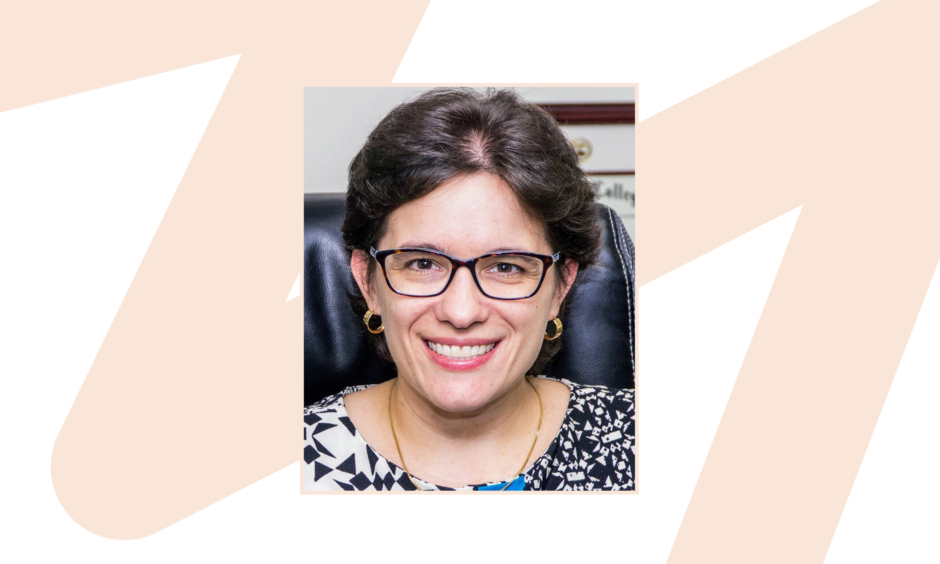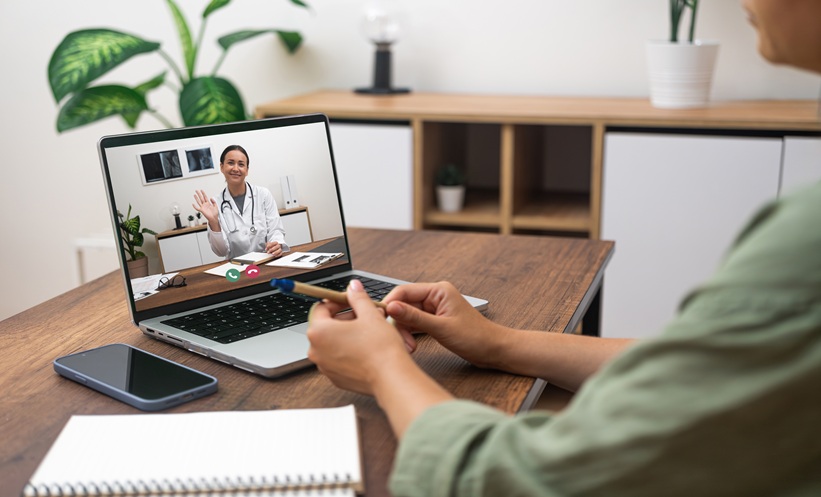Christine Peoples, MD | Clinical Associate Professor of Medicine, Division of Rheumatology and Clinical Immunology, Department of Medicine, University of Pittsburgh Medical Center (UPMC), Pennsylvania, USA; Director, Telerheumatology Program, UPMC
Citation: EMJ Rheumatol. 2023; DOI/10.33590/emjrheumatol/10302962. https://doi.org/10.33590/emjrheumatol/10302962.
![]()
What led you to pursue a career in rheumatology?
There are two main reasons that led me to pursue a career in rheumatology. Growing up, I was a voracious reader (I still am). I loved mysteries such as the Nancy Drew series and all books by Agatha Christie. I knew I wanted to be a doctor from a young age, and so, when I was in college, I started learning about the field of rheumatology. It seemed as though rheumatologists received the medical mysteries to solve. After attending medical school, it seemed like a natural progression to choose rheumatology as my field of study. When we had cases on rounds that no one had a sense of what was going on with the patient or how to interpret certain test results, they called rheumatology. That aspect really drew me to it, and it still does to this day.
The second reason is taking care of patients over time. There are many aspects of long-term care that I enjoy with primary care, but I wanted to specialise. As rheumatologists, we are “super internists”, and we do maintain long-term relationships with patients. We must have a strong foundation of all internal medicine concepts. I love that part about it.
Those two reasons are what really drew me to rheumatology, and still pique my interest to this day.
You are an advocate for telemedicine. How do you see this changing the field of rheumatology in the near future?
I feel telemedicine has already changed the field of rheumatology in many ways, and I think it will continue to change it. In the US, we face a significant shortage of rheumatologists. We need to have ways to provide rheumatology care to those that live in rural areas and to those that cannot access our clinics in the cities for various reasons.
When I started seeing patients through telemedicine, there was a great need in rural and underserved areas of Pennsylvania, along with the surrounding states. Many states in the US are similar, with most rheumatologists clustered in cities. We have examined access issues for patients, and we estimate, in rural and underserved areas of Pennsylvania, that 40–50% percent of patients would just never see a rheumatologist. I could not let that go; patients needed rheumatology care.
Patients are seen at rural telehealth centres, where there are registered nurses that I have personally trained do a comprehensive rheumatological exam. I am on the screen the entire visit, and we talk about everything; there is a great deal of patient “contact” with me, even though I am not physically there. We have worked very hard over the years to optimise a thorough physical exam. Visually, I can see a lot; we have different cameras. We have a Bluetooth stethoscope so I can hear heart and lung sounds. I’ve been very fortunate to work with the same teams over the past decade at all the telehealth centres. Our teams are committed to provide rheumatology care in this way.
The COVID-19 pandemic was telerheumatology on steroids. Everybody had to be seen remotely, especially when cases were high. Then, that put the focus on: “Hey, wait a second, we need to restructure this, and ensure there’s greater access. How can we make it better? How do we get all this organised with patients?” I always love to hear about patient experiences with telemedicine. We obtain surveys about the patient’s experience, and how long it took them to block off time from work or manage childcare to come to appointments, because for most folks, it’s not a quick appointment. There’s a lot to talk about and consider, including their symptoms and treatment options. If they can drive only a short distance to the telehealth centre, or even stay at home, that is a big savings for them. We focus on how we can optimise providing virtual care, as there are different modalities to do so. Telehealth was already changing rheumatology, and, with the COVID-19 pandemic, it has skyrocketed.
What does your role as Director of the Rheumatology Telemedicine Program at UPMC involve, and are there any challenges associated with this role?
One of the biggest aspects that I focus on is how to innovate telehealth modalities. We always receive requests about opening new telehealth centres. Are we able to open new locations to service a bigger area of patients? Yes, we can! We were able to hire another rheumatologist to join me last year, and that’s been wonderful. We have also hired our own nursing staff for our telehealth patients. We are optimising getting the word out to all the communities we serve.
One of the biggest things that we struggle with, and I think we always will, is medical records. Many patients I see are not within our own UPMC electronic medical record and obtaining outside records remains a challenge. Communication with primary care providers can also be a challenge, as well as managing referrals. There is a significant lack of primary care in rural areas, not just a rheumatology shortage. Currently, we are working on how we can further improve the physical exam. Several of my colleagues specialize in areas like myositis and scleroderma. How can we incorporate their exam pearls into the virtual exam? There is a great deal we can do visually. We are working on revamping some of the nursing training videos, and whether there are other cameras to use with other tools in the physical exam. We can take pictures of a patient’s hands and feet, for example, and upload the pictures into the chart. For example, for rheumatoid arthritis patients, we can have standard views that we obtain on each patient.
What were the main focuses and aims of the ‘Telerheumatology’ textbook that you edited and authored chapters for?
This was the first work of its kind. The whole concept arose during the COVID-19 pandemic, and that is when I was approached to lead the project. Most people that provided care like this before the pandemic I did not know on a personal level, so I did a great deal of outreach via email. I was fortunate that most people I contacted said they would love to be involved in the project. I was able to network with other rheumatologists, and outline how remote rheumatology care is approached internationally. Since telemedicine is such an umbrella term, it was interesting to see whether we could standardise things, and how we could improve aspects of care for our patients. The book details the fundamentals of providing virtual care in the field of rheumatology. I lead and direct our rheumatology eConsult program. Rheumatology eConsults, which are provider-to-provider consultations, allow us to replace so-called ‘curbside consults’, where our colleagues in primary care and other specialties ask what they should do with a particular patient with a rheumatology concern. With an eConsult, we have appropriate documentation in the medical record. We review the patient’s records and provide recommendations. All telehealth modalities provide a challenge, in that we have choices. You can come to the office for regular visit. You can have a visit from home. You can go a telehealth centre for a visit. You can provide eConsults. What is the best way to make the visit type choice and how can we make this process efficient?
The textbook outlines the breadth of what we do, and leaves the questions: how do we optimise this, and how do we make it easy to select these different visit types? We certainly need more research, and more systematic reviews. The textbook is mainly targeted to rheumatologists and rheumatology trainees. There is a great deal of information that would be relevant to primary care, and for the support staff we work with, such as nurse practitioners, physician assistants, and nurses, that are involved in different telehealth modalities.
Do you believe there are any misconceptions about the field of rheumatology?
I still think rheumatology is a “black box” for most people. I was the only one in my medical school class that went on to pursue a career in rheumatology, and the only one in my residency class. It’s still viewed as very complicated. There are many blood tests, as well as numerous symptoms: how do we evaluate these patients? A lot of people just put up their hands and say they just don’t understand rheumatology. It’s our job as rheumatologists to help educate our colleagues about certain fundamental concepts in rheumatology. I think gout is an excellent example; it’s so common and is becoming more common. There is no way rheumatology can take over the management for all patients with gout, so we need to outline to primary care providers, and other specialists, the basics. This starts at the medical student level in terms of teaching, through residency, and then fellowship. I think getting over that hump is key, instead of “I don’t know, just refer.” What do they need to know, and when should they suspect something else is wrong, or something rare is happening?
UPMC is a world-renowned healthcare provider, pioneering ground-breaking research and treatments. What do you think other hospitals could learn from how you operate?
One of the biggest aspects at UPMC is innovation. We had most of our virtual care in place before the COVID-19 pandemic, investing in telehealth centres around 10–15 years beforehand. When COVID hit, we already had the foundation for telehealth centre visits, as well as home audio-visual visits. We had the technology, and a user-friendly application. UPMC is two or three steps ahead of other centres, and I think some of it is because so many people travel to see us, and we have experts in all fields. We use telehealth care with stroke care and ICU care, as there are many rural hospitals that need a lifeline to the bigger hospitals, rather than thinking that everybody needs to be transferred.
Another challenge going forward is how we can arm everybody with the appropriate device. Many of our rural patients don’t have a device, or access to Wi-Fi. Many libraries and community centres have private rooms at their facilities for patients to go and have visits with their doctor. The device is there, and the Wi-Fi connection is good, versus always relying on the patient’s home Wi-Fi and device. With the pandemic, those that had the technology were fine, and could access the visit, but it was a struggle for those that did not have an appropriate device and/or Wi-Fi connection.
Are there any unique challenges and/or opportunities associated with practising as a rheumatologist in the USA compared to Europe?
I laughed a little bit at this question because I am not very familiar with rheumatology practices in Europe. I feel a big issue in the US is the cost of medications. I don’t know if it’s necessarily that much better in Europe, but in the US, it’s atrocious. We always have the example outside of rheumatology of insulin and diabetes, but for us there are the biologic medicines. It’s still such a struggle to get them approved and affordable for patients. And then a lot of times, it’s just a “no”. For our patients, because they typically have more than one thing going on, when they go to pay for medication, it really starts to add up for people, especially if they’re on a fixed income. The approval process is a roadblock, with the paperwork and staff required. If people lose insurance, or their insurance plans change, or they lose their job, it’s a big deal. I’m hoping it’ll get better with the biosimilars that are emerging on the market.
Another huge issue, especially with telehealth, is medical licensure. Pennsylvania is a state that doesn’t participate in the state licensure compact. Some states have no paediatric rheumatologists, and maybe only five or six adult rheumatologists. There are some states that maybe have one or two. And you think, why can’t a rheumatologist in another state take care of these folks? Licensure is a big roadblock. I currently just have a license in Pennsylvania, so patients living in bordering states must travel. Because everything is focused on where the patient is rather than where the doctor is, some physicians choose to get licenses in different states. That starts to become very cumbersome because it must be renewed every year. For rheumatologists, if patients have more rare conditions, there could be nobody specialised enough in their state. We need to have relaxed licensure requirements, and I hope this changes. A lot of it has to do with money and insurance limitations, and I think that’s one of the bigger considerations in the US.
Where will your clinical and research focuses lie in the coming years?
A lot of it will be trying to get to the crux of picking the type of visit; whether we can give providers some guidance about when to order something like an eConsult versus a regular visit versus the telehealth centre. Educating our own colleagues in rheumatology and referring providers about the many ways to see patients, and which option is most appropriate, is key. This could be different depending on the disease activity of the patient, and how they’re doing. I also want to focus on arming primary care providers with more tools for appropriate rheumatology referrals. The primary care workforce has a great deal of turnover. When you think about the top reasons people go to any doctor, it is often joint pain, back pain, and fatigue. You can make a case that these reasons are all relevant to rheumatology, but there is no way we can accommodate all that as a specialty. That’s a big challenge. And then training! Our rheumatology fellows need to know about these ways of telehealth care, even if most rheumatology fellows aren’t going to focus on telehealth care modalities for the bulk of their career. However, even those who focus on clinical research or basic science research, need to recruit patients. Recruitment for clinical trials and research must consider virtual options.








